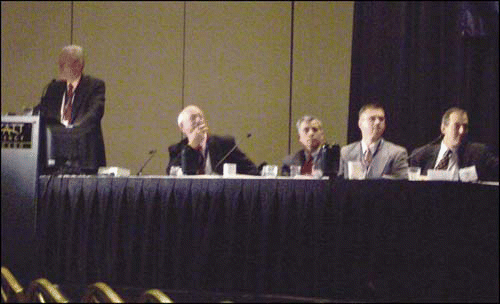Dr. Har-El said, “I was taught to just take [the mass] out—that that’s treating the patient. But I’ve seen more and more cases where there may be some exception. So now I ask for CT scan and needle biopsy.” Dr. Smith agreed: “Fine needle aspiration is used for everyone in our practice, pretty much. It’s our first diagnostic; it helps me decide whether the patient needs imaging or not.”
Explore This Issue
July 2006Next, Dr. Persky revealed the second phase of the case study: A fine needle aspiration (FNA) biopsy showed cellular pleomorphic adenoma, with possible low-grade mucoepidermoid carcinoma. What now?
Dr. Descher began: “I don’t know that every patient who has a mass removed needs the same treatment. I mean, do you trust the report if it comes from an outside pathologist? We have our own pathologist look at the results. We still have to consider that it may be malignant.” Dr. Persky’s response to this was, “It all depends on your experience. Do you believe imaging is necessary?” Dr. Donald agreed that pathology can be deceptive. “You’re often influenced by your last experience,” he mused. After a recent experience with questionable pathology, he said, “I’m more inclined to order CT scans now.”
Asked about concerns with FNA biopsies spreading disease, every member of the panel said they were not concerned.
Dr. Persky went on: The patient undergoes a CT scan, which shows the mass. It may be a benign tumor. The next issue in the standard of care: discussing the operation with the patient.
Standards for Discussion of Operation
The panel was asked how each would handle pre-operative topics including risks, complications, and sequella. Dr. Descher said, “I talk about what may be required, and the side effects of that. I quote national data on complications that occur. It’s critical to discuss handling the possibility of malignancy. As I was taught, everything you tell the patient before an operation is information; everything you tell them afterwards is an excuse.” He added, “I also tell them about my personal experience with similar cases, but I also warn them that that doesn’t mean they won’t have complications.”
Dr. Har-El said he covers sequella in detail in pre-operative discussions. “I tell them it’s not unusual to wake up with a numb ear lobe,” he said. “I cover side effects—and I do use the term ‘side effects’ rather than complications or sequella.”

Dr. Smith said that his practice has simplified these discussions in the last few years. “We focus on scarring and malignancy risk,” he said, because these seem to be the two biggest concerns of patients. “Also, I tend to quote my own statistics [on patient complications] rather than the national data. I believe it’s more meaningful to them.”
Leave a Reply